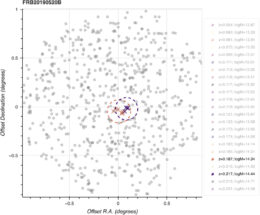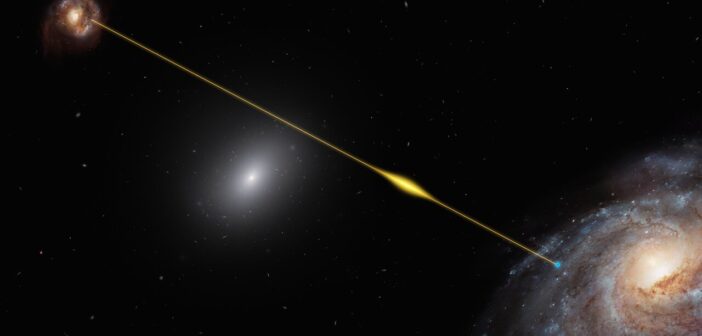The repeating fast radio burst FRB 20190520B traveled through an unusually large amount of matter on its journey to Earth. Could unidentified galaxy clusters in the billions of light-years that separate us from the burst’s source explain why?
An Astrophysical Mystery
Fast radio bursts are among the most mysterious events in the universe. Most of these powerful, milliseconds-long radio blips occur just once, each burst an astronomical flash in the pan that leaves researchers puzzling over its origin. In rare cases, fast radio bursts repeat, giving us a clue that at least some sources of these mysterious bursts survive the event.

The signal from the first fast radio burst ever detected. The highest frequencies arrive first, and the lower frequencies follow. [Wikipedia user Psr1909; CC BY-SA 4.0]
The matter that delays the arrival of the lowest-frequency radio waves in a burst — free-roaming electrons are the best at holding up low-frequency waves — can be located anywhere along the burst’s path: in the immediate vicinity of the source, in the source’s host galaxy, in intergalactic space, or in our own galaxy. To disentangle the contributions from these different regions, researchers must take a wide view of the situation.
Surveying a Superlative Burst
The dispersion measure of the repeating fast radio burst FRB 20190520B is more than twice as large as expected given its distance. This unusually high value caught the attention of a team led by Khee-Gan Lee (Kavli Institute for the Physics and Mathematics of the Universe), which is carrying out the Fast Radio Burst (FRB) Line-of-sight Ionization Measurement From Lightcone AAOmega Mapping survey, or FLIMFLAM. This survey aims to map the distribution of luminous matter in the universe by searching for galaxy groups that are revealed by fast radio bursts.

Snapshot of an interactive figure showing the locations of the newly identified galaxy clusters relative to FRB 20190520B’s location. Click to enlarge. You can interact with this figure here. [Lee et al. 2023]
A Revised Estimate
Based on FRB 20190520B’s extremely high dispersion measure, previous research estimated its host galaxy’s dispersion to be the highest of any known fast radio burst, a fact that has been difficult to reconcile with other observations of the galaxy. Now, with the new estimate of the foreground galaxies’ contribution, FRB 20190520B’s host galaxy has been assigned a more moderate value that aligns with its observational properties. This study demonstrates that even when focusing closely on a single fast radio burst, it’s still important to zoom out and consider the big picture!
Citation
“The FRB 20190520B Sight Line Intersects Foreground Galaxy Clusters,” Khee-Gan Lee et al 2023 ApJL 954 L7. doi:10.3847/2041-8213/acefb5

